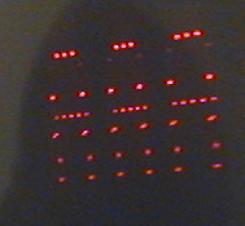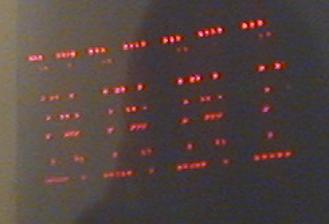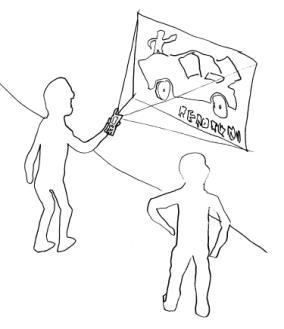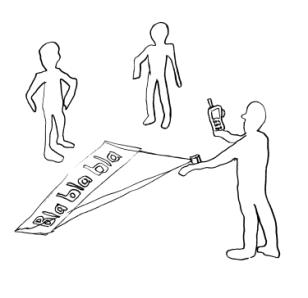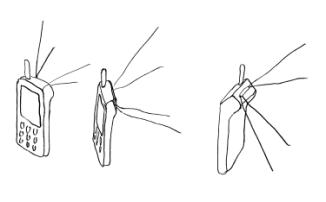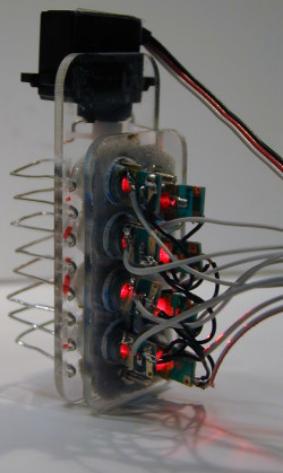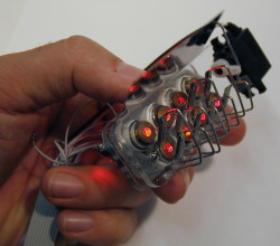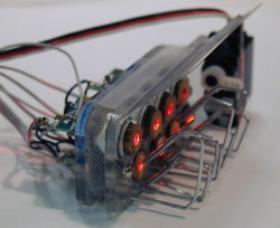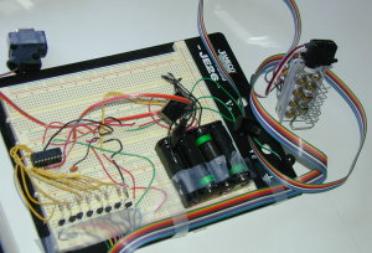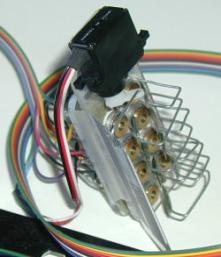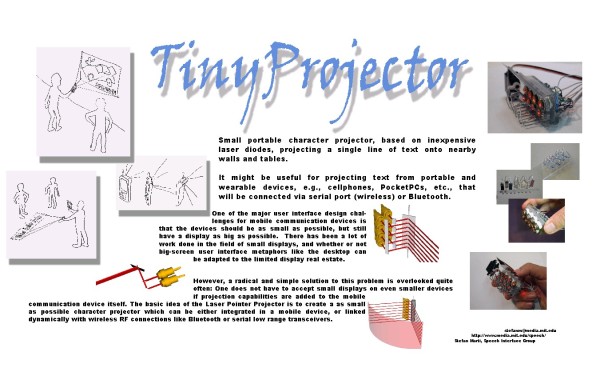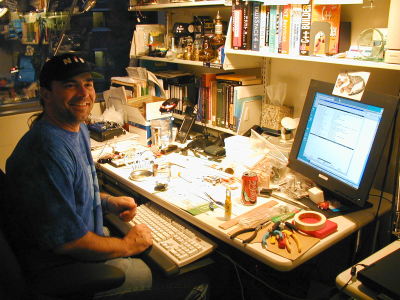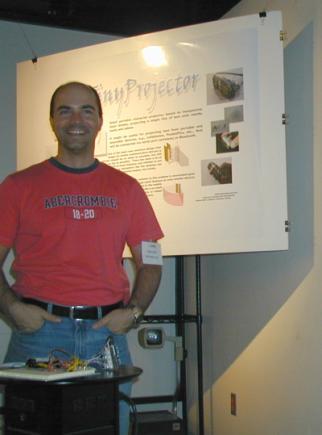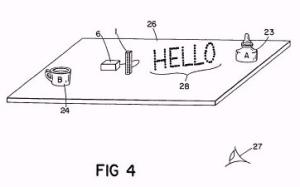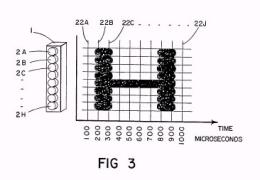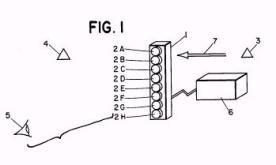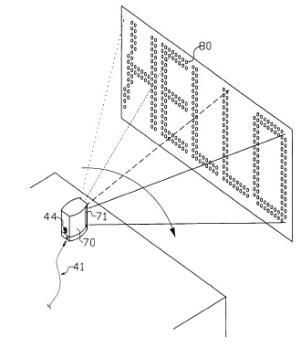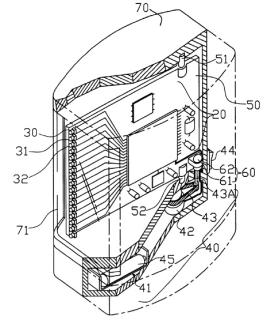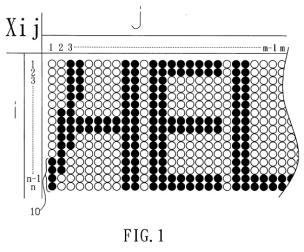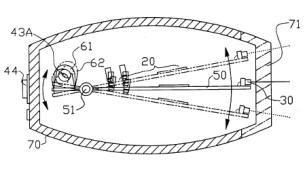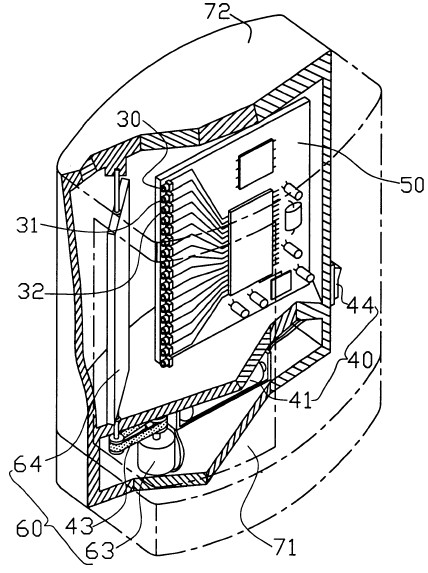Diary of October 2001 8-16
October 8, 2001I tried to set up a serial connection to the Palm Pilot. It didn't work, even after inserting resistors into RS232 pins on PIC.
C code for TinyProjector prototype2
Since the serial connection did not work at this time, I made the projector go through a sequence of a few different projections (Figure 27).
After a lot of tweaking, the projection of the second prototype seems acceptable to me. The refresh rate is about 3Hz, which means it relies on Persistence of Vision principles. [This will not be the case anymore in the next prototype.]
After the demo started to work properly, I still had to design a poster (which first required installing software on a laptop, like Thumbs and Photoshop).
First I made some hand drawings (Figure 29), and digitized them.
Then I took tons of pictures of the prototype (Figure 30).
After designing the poster (Figure 31), I had to fix the plotters (I actually did both Hammersmith and Lenz), printed it out, cut it manually, and spray-glued it onto cardboard.
[Note: I did not sleep this night either, only October 9 afternoon from 2pm till 7pm.]
October 9, 2001Demoed TinyProjector prototype 2 9:30 – 12:30 during I/O Open House at the MIT Media Lab.
October 11, 2001I demoed TinyProjector prototype 2 from 15:00 – 18:00, during Digital Life open house.
I replaced 7 laser diodes after I accidentally connected 4.8V (power supply!) instead of 4.5V: four of them were down to 20% brightness; three more broke later. (The original idea I had was to start the laser projector demo with a Clapper! But in order to use the Clapper, I had to use a power supply instead of the 3 alkaline cells. Unfortunately, the power supply had 4.8V instead of 4.5V…)
During these extensive repairs, I had an idea: In order to speed up the repair time, why don’t I just screw the laser diodes into the acrylic? And don't solder the contacts, but just clip the cables on. (I never implemented this idea.)
Credits: These people helped me with the second prototype of TinyProjector:
o Deva Seetharam (deva@media.mit.edu): for the idea that we had during the Tangible interfaces class in October 2000 o Natalia Marmasse (nmarmas@media.mit.edu): C problems, circuit problems o Vadim Gerasimov (vadim@media.mit.edu): original circuit design o Rob Poor (r@media.mit.edu), Matt Reynolds (matt@media.mit.edu), and hackers on hackers mailing list: electronics details o Bakthiar Mikhak (mikhak@media.mit.edu): PIC programmer o Borglab: cables o Hannes Vilhjalmsson (hannes@media.mit.edu) and GNL (wires, foam)
Feedback from interactions during open house:
o
The Private Eye (like Bradley Rhodes has
been wearing) is based on the same principle: a row of red LEDs and a vibrating
mirror:
o Matt Reynolds (matt@media.mit.edu) suggests using smaller mirrors that are balanced, and probably require a far smaller servo. [I will follow this suggestion during design of the next prototype.]
October 16, 2001I met with Sloan Kulper (sloan@media.mit.edu) from John Maeda's group. I showed him my demo, and he told me what he is working on, which is very related (http://acg.media.mit.edu/people/sloan/June.html/index.html).
We were talking about the novelty of our work, and started to look into the US Patents database. Indeed, we found a long list of very related work:
Most of these patents are based on persistence of vision projection with LEDs, (like for the Skyliner™ and the Private Eye. For example, patent number 4470044 (Figure 34):
“Momentary visual image apparatus A modulated array of lights for the creation of momentarily perceptible visual images when scanned asynchronously by the human eye during characteristic saccadic eye movements between points of eye fixation is described in the disclosure. The array and modulation style are chosen to provide an image that matches the span of the human eye/brain combination for recognition of tachistroscopically presented lines of text, other symbols, and pictorial images, and to achieve an illusory effect wherein the momentary image appears dissociated from the array of lights and appears superimposed on the scene of eye fixation just prior to initiating the saccadic movement. A preferred embodiment using light emitting diodes and large-scale integrated logic circuitry is described for generation of words, phrases up to 32 characters long, and simple pictures.” (Patent filed May 15, 1981, awarded September 4, 1984.)
The illustrations speak for themselves. Most of the other patents are very similar.
However, the patent number 6222459 is different because is explicitly mentions laser diodes, and is therefore very close to my work (Figure 35):
“Method of word screen formation by laser light projection and the structure for the same The present invention relates to a method of word screen formation by laser light projection and the structure of word formation by laser light projection, and in particular, relates to a plurality of laser production devices arranged in a single column and by rapid reciprocating action of the devices to project multiple columns of light track and form word arrays.” (Patent filed July 22, 1999, awarded April 24, 2001)
Up to that point, there is still the rotating mirror concept missing, but the very last illustration/claim describes exactly this variation of the above projector (Figure 36):
Claim 5 pretty much describes the full rotational two-faced mirror version of my idea.
However, as I will describe later in this lab notebook, a system with such a mirror design is very inefficient and can work only with very high power laser diodes since with such a mirror configuration, the duty cycle of the lasers is far from optimal.
I wonder if the inventor of this patent, Mr. Chih-Yu Ting from the Taiwanese company OPCOM Inc. (http://www.opcomgroup.com/main.htm), a laser and CCD products producer, has actually built the projector described in claim 5. I doubt it very much.
Note that this patent was awarded after I started working on this project.
Send me some comments! Copyright © 1997-2004 by Stefan Marti and MIT Media Lab. All rights reserved | ||||||||||||||||||||||||||||||||||||||||||||||
